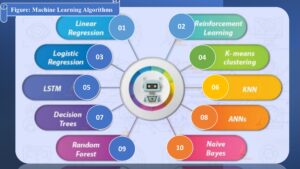Machine learning algorithms are being applied in almost every field today. What exactly is machine learning and why should we care? Machine learning algorithms are now being used in almost every field today, from medicine to finance to marketing. They are even being used to predict stock prices and identify fraud. This article will be covered by the discussion on several machine learning algorithms. Let us have a look at the algorithms and machine learning before elaborating on several machine learning algorithms.
Table of Contents
What is the Machine Learning?
Machine learning is a branch of artificial intelligence (AI) that allows computers to learn without explicitly programmed instructions. The goal is to create programs that can perform tasks automatically, such as recognizing patterns or identifying objects.
What is an algorithm?
An algorithm is a collection of finite rules or instructions to be followed in calculations or other problem-solving procedures. In other words, an algorithm is a finite-step process for solving a mathematical problem that frequently uses recursive operations.
What is the Machine Learning algorithm?
In these highly dynamic times, a wide variety of machine learning algorithms have been developed to assist to resolve challenging situations in the real world. Depending on what you want to do, algorithms might range from simple to hard. The most popular machine learning algorithms are listed in the article. Almost every data problem can be solved using these algorithms. For your convenience, the algorithms are enlisted here too and elaborated further.
- Linear Regression (LiR)
- Logistic Regression (LR)
- Decision Tree (DT)
- Support Vector Machine (SVM)
- Naive Bayes (NB)
- KNN algorithm
- K-Means algorithm (KM)
- Random Forest (RF)
- Dimensionality Reduction (DR)
- Gradient Boosting (GB)

The machine learning algorithms are elaborated on below:
Linear Regression
Linear regression is a machine learning algorithm based on supervised learning. It executes a regression operation. Regression uses independent variables to model a goal prediction value. It mostly serves to determine how factors and forecasting interact. The dependent variable is the one you want to predict. The independent variable is the one you’re using to make a prediction about the value of the other variable.
The task of predicting a dependent variable’s value (Y) based on an independent variable (X) is carried out using linear regression. Therefore, X (the input) and Y (the output) are found to be linearly related by this regression technique. Thus, the term “linear regression” was coined. The hypothetical function for Linear Regression is Y = mX +C, where
Y = Dependent Variable as Target Variable
X = Independent Variable as predictor Variable
m = Linear regression coefficient
C = Intercept of the line
The model fits the best line to predict the value of y for a given value of X during training. By locating the best values of m (slope) and C (intercept), the model produces the best regression fit line. Two different types of linear regression models exist.
- Simple Linear Regression: A linear regression procedure is referred to as simple linear regression if only one independent variable is utilized to predict the value of a numerical dependent variable.
- Multiple Linear Regression: A linear regression procedure is referred to as multiple linear regression if it uses many or more than one independent variables to predict the value of a numerical dependent variable.
Logistic Regression
One of the most well-known machine learning algorithms that fall within supervised learning techniques is logistic regression. Logistic regression is generally used to estimate the discrete values (often binary values like 0/1 or yes/no) from a set of independent variables. To forecast the categorical dependent variable, logistic regression is used. In other words, it is employed when the prediction is categorical, such as when it is a binary choice such as yes or no, true or false, or 0 or 1. Linear and logistic regression are the two well-known machine learning algorithms that fall within the category of supervised learning. Read the differences between the linear and logistic regression algorithms.
Decision Tree
A decision tree is a tree structure that represents decisions and their outcomes. It is one of the most widely used machine learning algorithms nowadays. it is a supervised learning method used to classify problems. In a decision tree, nodes represent conditions and branches represent possible actions. Each leaf node represents a single outcome. The population is split into two or more homogeneous sets using this procedure, depending on the most important characteristics or independent variables. Both categorical and continuous dependent variables can be used to work on this algorithm.
Support Vector Machine
Support vector machines (SVMs) are supervised learning algorithms that find a separating hyperplane between two classes of data points. SVMs are widely used in pattern recognition, data mining, knowledge discovery, regression analysis, and classification tasks. In this algorithm, you can classify data by plotting the raw data as dots in an n-dimensional space.
Naive Bayes
Naive Bayes classifiers are probabilistic models that assume conditional independence among features given the class variable. Naive Bayes classifiers use Bayesian inference to make predictions about the target variable. A Naive Bayesian model is simple to construct and effective for large datasets. It is known to perform better than even the most complex categorization techniques despite being basic.
K- Nearest Neighbors (KNN)
K-nearest neighbors (KNN) is a nonparametric classification method that makes predictions based on the majority vote of its k-nearest neighbors. kNN is similar to linear discriminant analysis except that instead of finding a single linear combination of features, kNN finds the weighted sum of features that maximizes the separation between classes. Problems involving regression and classification can both be solved with this technique.
K-Means algorithm
It is a technique for unsupervised learning that addresses clustering issues. Data sets are divided into a certain number of clusters—call let’s it K—in such a way that each cluster’s data points are homogenous and heterogenous from the data in the other clusters. Here, K determines how many pre-defined clusters must be produced as part of the process; for example, if K=2, there will be two clusters, if K=3, there will be three clusters, and so on.
Random Forest
A group of decision trees is referred to as a “Random Forest”. Random forests are ensemble methods for classification and regression. Ensemble methods combine predictions from several weak learners to produce a stronger learner. Random forests are an example of bagging, a technique for generating multiple weak learners. Bagging creates a collection of decision trees at training time and uses bootstrap aggregating to generate predictions.
Dimensionality Reduction
Dimensionality reduction reduces the number of variables or eliminates the variables that aren’t as relevant to the model. This will lessen the complexity of the model and decrease some of the data noise. This is how dimensionality reduction lessens the effects of overfitting.
Gradient Boosting Machine
Gradient boosting machines (GBM) is a family of supervised learning algorithms that build predictive models by sequentially adding weak predictors to improve model performance. GBM builds a sequence of additive models that minimize the loss function. GBM is employed when dealing with a large amount of data to produce a prediction with high prediction power. These boosting algorithms consistently do well in data science contests such as Hackathons, CrowdAnalytix, and Kaggle.
Conclusion
You could learn more about machine learning algorithms by reading this article. I wrote this post with the express purpose of educating readers about machine learning algorithms in a straightforward manner. R and Python programs can be written to utilize these algorithms. Start right away if you’re eager to master machine learning algorithms. Take challenges, gain a physical understanding of the algorithms, use R and Python programming, and enjoy yourself!
FAQ
Question: What are the 3 types of machine learning?
Answer: Supervised, unsupervised, and reinforcement learning are the three categories of machine learning.
Question: What is the simplest machine learning algorithm?
Answer: One of the most straightforward and well-liked unsupervised machine learning algorithms is K-means clustering.
Question: What are the main 3 types of ML models?
Answer: Binary classification, multiclass classification, and regression are the three different types of ML models.
Question: What exactly machine learning means?
Answer: It means, a machine’s capacity to mimic intelligent human behavior.


1 thought on “Machine Learning Algorithms in 2023. Simply explained”